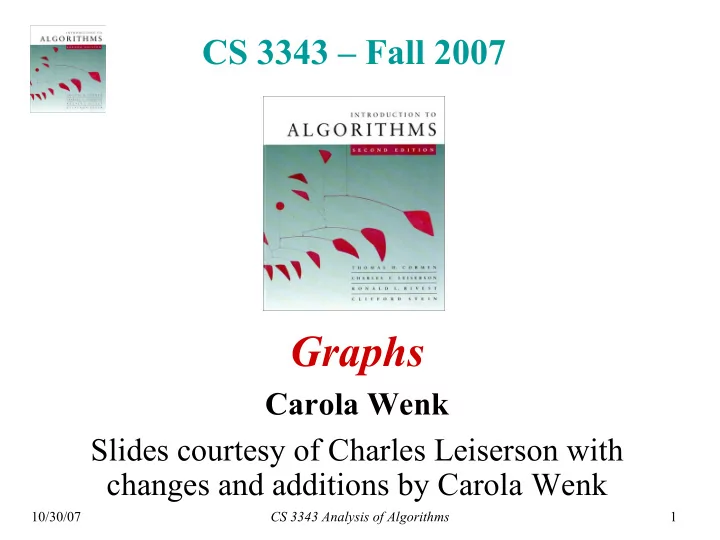

CS 3343 – Fall 2007 Graphs Carola Wenk Slides courtesy of Charles Leiserson with changes and additions by Carola Wenk 10/30/07 CS 3343 Analysis of Algorithms 1
Graphs Definition. A directed graph ( digraph ) G = ( V , E ) is an ordered pair consisting of • a set V of vertices (singular: vertex ), • a set E ⊆ V × V of edges . In an undirected graph G = ( V , E ), the edge set E consists of unordered pairs of vertices. In either case, we have | E | = O (| V| 2 ). (Review CLRS, Appendix B.4 and B.5.) 10/30/07 CS 3343 Analysis of Algorithms 2
Adjacency-matrix representation The adjacency matrix of a graph G = ( V , E ), where V = {1, 2, …, n }, is the matrix A [1 . . n , 1 . . n ] given by 1 if ( i , j ) ∈ E, A [ i , j ] = 0 if ( i , j ) ∉ E. A 1 2 3 4 2 1 Θ (| V| 2 ) storage 2 1 1 0 1 1 0 ⇒ dense 2 0 0 1 0 representation. 3 4 3 0 0 0 0 3 4 4 0 0 1 0 10/30/07 CS 3343 Analysis of Algorithms 3
Adjacency-list representation An adjacency list of a vertex v ∈ V is the list Adj [ v ] of vertices adjacent to v . Adj [1] = {2, 3} 2 1 2 1 Adj [2] = {3} Adj [3] = {} 3 4 3 4 Adj [4] = {3} For undirected graphs, | Adj [ v ] | = degree ( v ). For digraphs, | Adj [ v ] | = out-degree ( v ). 10/30/07 CS 3343 Analysis of Algorithms 4
Adjacency-list representation Handshaking Lemma: Every edge is counted twice • For undirected graphs: ∑ v ∈ V degree(v) = 2 | E | • For digraphs: ∑ v ∈ V in-degree(v) + ∑ v ∈ V out-degree(v) = 2 | E | ⇒ adjacency lists use Θ (| V| + |E| ) storage ⇒ a sparse representation 10/30/07 CS 3343 Analysis of Algorithms 5
Graph Traversal Let G =( V , E ) be a (directed or undirected) graph, given in adjacency list representation. | V | = n , | E | = m A graph traversal visits every vertex: • Breadth-first search (BFS) • Depth-first search (DFS) 10/30/07 CS 3343 Analysis of Algorithms 6
Depth-First Search (DFS) DFS( G= ( V,E )) O( n ) Mark all vertices in G as “unvisited” // time=0 for each vertex v ∈ V do O( n ) if v is unvisited without DFS_rec( G , v ) DFS_rec DFS_rec( G, v ) O(1) visit v // time++ for each w adjacent to v do if w is unvisited O( deg ( v )) Add edge ( v , w ) to tree T without DFS_rec( G , w ) recursive call ⇒ With Handshaking Lemma, all recursive calls are O(m), for a total of O( n + m ) runtime 10/30/07 CS 3343 Analysis of Algorithms 7
DFS runtime • Each vertex is visited at most once ⇒ O( n ) time • The body of the for loops (except the recursive call) take constant time per graph edge • All for loops take O( m ) time • Total runtime is O( n + m ) = O(|V| + |E|) 10/30/07 CS 3343 Analysis of Algorithms 8
Breadth-First Search (BFS) BFS( G= ( V,E )) Mark all vertices in G as “unvisited” // time=0 O( n ) Initialize empty queue Q O(1) for each vertex v ∈ V do if v is unvisited O( n ) visit v // time++ BFS_iter( G ) without Q .enqueue( v ) while Q is non-empty do BFS_iter BFS_iter( G ) v = Q .dequeue() for each w adjacent to v do if w is unvisited O( m ) visit w // time++ O( deg ( v )) Add edge ( v , w ) to T Q .enqueue( w ) 10/30/07 CS 3343 Analysis of Algorithms 9
BFS runtime • Each vertex is marked as unvisited in the beginning ⇒ O( n ) time • Each vertex is marked at most once, enqueued at most once, and therefore dequeued at most once • The time to process a vertex is proportional to the size of its adjacency list (its degree), since the graph is given in adjacency list representation ⇒ O( m ) time • Total runtime is O( n + m ) = O(|V| + |E|) 10/30/07 CS 3343 Analysis of Algorithms 10
Recommend
More recommend